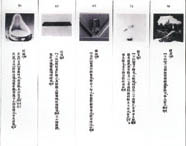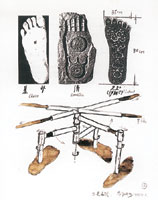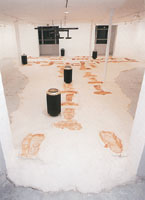Dada
is Dead, Beware of the Fire!
An Interview with Huang Yong Ping
by Ya-Ling Chen
YLC: You also made Repacking Catalogue: It is Most Easy to Set a Beard on Fire (1986-87). (Fig. 5) Borrowing a concept in which Dechamp appropriates works by masters from the history of art, Repacking Catalogue seems to be the counterpart of L.H.O.O.Q. (Fig. 6).
|
click
to enalrge
|
|
 |
 |
|
Figure
5
|
Figure
6
|
|
Huang Yong Ping, Self-Portrait?
da Vince? or Mona Lisa?, 1986-87
|
Marcel Duchamp, L.H.O.O.Q.,
1919
|
HYP: In the mid-1980s, it was impossible to find a Duchamp catalogue in China. Nevertheless, catalogues by masters from the classical era are everywhere. There are four or five similar works in the Repacking Catalogue series. After finishing Set a Beard on Fire, I said, "You see, da Vinci is still perfectly relaxed even his beard has caught fire." Accidentally, I placed the cheap publication against the light. The images on both sides of the catalogue overlapped--the image of da Vinci's Self-Portrait overlapped with that of the Mona Lisa on the opposite page. After the painting is finished, friends discovered that "It looks just like you." Thus, I titled the work as Self-Portrait? da Vinci or Mona Lisa?
TF: You began
the Dust Collecting Project in 1987. (Figs. 7
& 8) What is the content, process and the result of this
particular project?
|
click
to enalrge
|
|
 |
 |
|
Figure
7
|
Figure
8
|
|
Huang Yong Ping, Dust Collecting
Project, 1987
|
Huang Yong Ping, Dust Collecting
Project, 1987
|
HYP: There are four pieces in the Dust Collecting Project series: the first one is the white canvas collecting greasy dirt and dust on the kitchen stove; the second is a roll of white paper pulled out from a self-made wooden box letting dust fall through time; the third piece is a canvas receiving dust from trimmed pencils by students in my drawing class at a high school where I used to teach; the last one is a glass bottle collecting dirt from the cleaning ritual at New Year's Eve. The last two are missing. They are supplementary to our daily life, not worth to pay special attention to.
TF: What was the reaction from the official and the public to the "Xiaman Dada" exhibition?
HYP: "Xiaman Dada" events did not attract huge crowds. During 1986 and 87, social climates in China kept changing recklessly. When we set the works on fire in the 1986 "Xiaman Dada" exhibit in front of the Cultural Palace of Xiaman, China, only some forty to fifty people participated. The "Event" exhibition at the Museum of Fine Art of Fujian lasted only two hours before it was being forced to shut down. However, albeit these uprisings happened only in small circles in the beginning, they were able to disseminate out eventually.
Rewriting example 4:
Art is dead, yet it is still happening;
art is happening, but it is dead. - Anonymous(2)
TF: Before leaving China, the inspiration from Dada is a kind of resonance from a distance (historically, culturally, and socially). Just out of curiosity, has the geographic and cultural relocation ever affected your reading of Duchamp?
HYP: I think what you mean is if in fact it is distance that evokes resonance; the change of distance would in turn create alienation. This perhaps relates with what I used to mention in 1991--the strategy of "Using the East to fight the West; Using the West to fight the East."
TF: From 1997 to 1998, you finished Thousand Armed Buddha and The Saint Leaned from a Spider to Weave a Cobweb. Before we talk about these works, have you also made any work inspired by Duchamp before 1997?
|
click to enlarge
|
||
 |
 |
 |
|
Figure
9
|
Figure
10
|
Figure
11
|
|
Claude
Yutault, Movable Chess Board, 1985
|
Huang Yong Ping, Water Jar,
1992
|
Huang Yong Ping, Water Jar,
1992
|
|
click to enlarge
|
 |
|
Figure
12
|
|
Huang Yong Ping, 108 Answers,
1993 (the 10th, 65th, 74th, 58th, and 59th Answers)
|
HYP: After
1989, there are several works associated with him. As a result of the
geographical change, my reading approach has shifted as well. In 1992,
Jean-Hubert Martin (the curator for the 1989 exhibition "Magician
of the Earth") organized the "Résistance" exhibition
at the WATARI-UM Museum in Japan. Four artists took part in this show,
including Duchamp's Chess Board, Green Box, and Coatrack.
Behind the wall where displays of Duchamp's Chess Board, the French
artist Claude Yutault installed his Movable Chess Board of 1985
(Fig. 9). I presented a giant tank filled
with water on top of the Movable Chess Board in a wide-opened courtyard.
I intended to imply the scene in which Marcel Duchamp and May Ray played
chess and then were washed away by water in 1942 (Figs.
10 & 11). It has to do with the "Food Chain"
between artists and their works. In the 108 Answers of 1993 (Fig.
12), I incorporated six components from works by Duchamp, such
as hair, a comb, a lock, a lamp, a urinal, and dust, with a well-known
book of Chinese herbal medicines, P'en-Ts'ao Kang-Mu, by Li Shin-Chen
(1590-96) from the Ming Dynasty. I attempt to tackle the possible interpretation
of substance in different cultures and eras. In the Trois Pas - Neuf
Traces project of 1993 at Ateliers d'Artistes de la Ville de Marseille,
France, Duchamp's Torture-Morte (1959) is transformed into The
Foot of Christ (Figs. 13, 14, 15, 16).
>> Next
|
click
to enalrge
|
|
|
Figure
13
|
Figure
14
|
|
Huang Yong Ping, Drawing and Study
for
Trois Pas – Neuf Traces,
1995
|
Huang Yong Ping, Floor plan for
Trois Pas – Neuf Traces,
1996
|
|
Figure
15
|
Figure
16
|
|
Huang Yong Ping, Trois
Pas – Neuf Traces, 1995
(Installation view) |
Huang Yong Ping, Trois
Pas – Neuf Traces, 1995
(Installation view) |
Notes
















